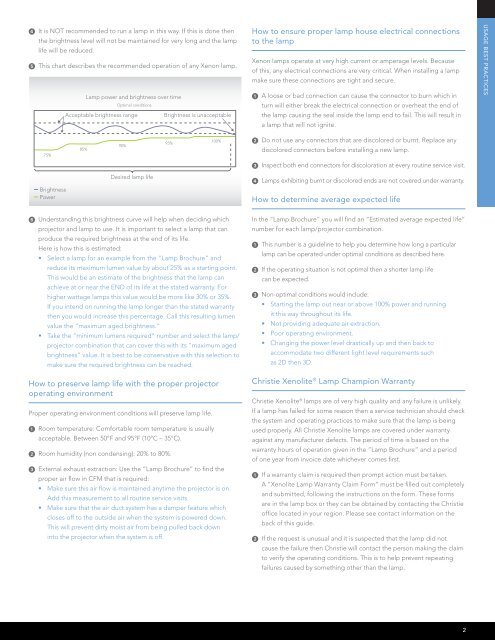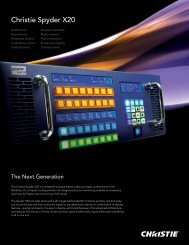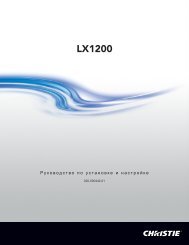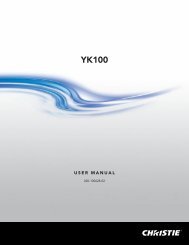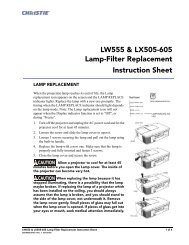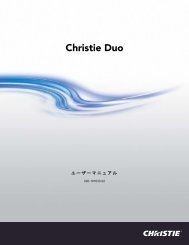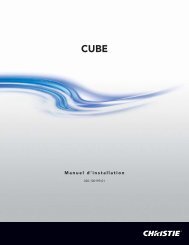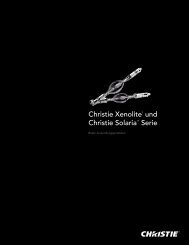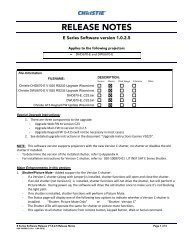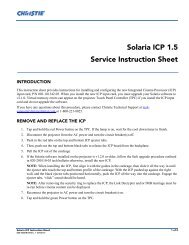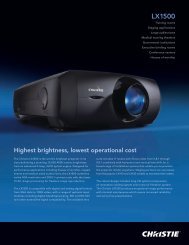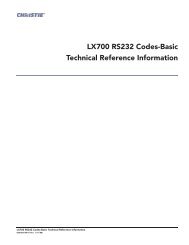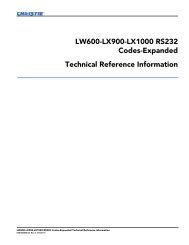Christie Lamp Best Practices Guide
Christie Lamp Best Practices Guide
Christie Lamp Best Practices Guide
You also want an ePaper? Increase the reach of your titles
YUMPU automatically turns print PDFs into web optimized ePapers that Google loves.
It is NOT recommended to run a lamp in this way. If this is done then<br />
the brightness level will not be maintained for very long and the lamp<br />
life will be reduced.<br />
This chart describes the recommended operation of any Xenon lamp.<br />
75%<br />
Brightness<br />
Power<br />
<strong>Lamp</strong> power and brightness over time<br />
Optimal conditions<br />
Acceptable brightness range Brightness is unacceptable<br />
85%<br />
90%<br />
Desired lamp life<br />
Understanding this brightness curve will help when deciding which<br />
projector and lamp to use. It is important to select a lamp that can<br />
produce the required brightness at the end of its life.<br />
Here is how this is estimated:<br />
• Select a lamp for an example from the “<strong>Lamp</strong> Brochure” and<br />
reduce its maximum lumen value by about 25% as a starting point.<br />
This would be an estimate of the brightness that the lamp can<br />
achieve at or near the END of its life at the stated warranty. For<br />
higher wattage lamps this value would be more like 30% or 35%.<br />
If you intend on running the lamp longer than the stated warranty<br />
then you would increase this percentage. Call this resulting lumen<br />
value the “maximum aged brightness.”<br />
• Take the “minimum lumens required” number and select the lamp/<br />
projector combination that can cover this with its “maximum aged<br />
brightness” value. It is best to be conservative with this selection to<br />
make sure the required brightness can be reached.<br />
How to preserve lamp life with the proper projector<br />
operating environment<br />
Proper operating environment conditions will preserve lamp life.<br />
Room temperature: Comfortable room temperature is usually<br />
acceptable. Between 50°F and 95°F (10°C – 35°C).<br />
Room humidity (non condensing): 20% to 80%.<br />
External exhaust extraction: Use the “<strong>Lamp</strong> Brochure” to find the<br />
proper air flow in CFM that is required:<br />
• Make sure this air flow is maintained anytime the projector is on.<br />
Add this measurement to all routine service visits.<br />
• Make sure that the air duct system has a damper feature which<br />
closes off to the outside air when the system is powered down.<br />
This will prevent dirty moist air from being pulled back down<br />
into the projector when the system is off.<br />
95%<br />
100%<br />
How to ensure proper lamp house electrical connections<br />
to the lamp<br />
Xenon lamps operate at very high current or amperage levels. Because<br />
of this, any electrical connections are very critical. When installing a lamp<br />
make sure these connections are tight and secure.<br />
A loose or bad connection can cause the connector to burn which in<br />
turn will either break the electrical connection or overheat the end of<br />
the lamp causing the seal inside the lamp end to fail. This will result in<br />
a lamp that will not ignite.<br />
Do not use any connectors that are discolored or burnt. Replace any<br />
discolored connectors before installing a new lamp.<br />
Inspect both end connectors for discoloration at every routine service visit.<br />
<strong>Lamp</strong>s exhibiting burnt or discolored ends are not covered under warranty.<br />
How to determine average expected life<br />
In the “<strong>Lamp</strong> Brochure” you will find an “Estimated average expected life”<br />
number for each lamp/projector combination.<br />
This number is a guideline to help you determine how long a particular<br />
lamp can be operated under optimal conditions as described here.<br />
If the operating situation is not optimal then a shorter lamp life<br />
can be expected.<br />
Non-optimal conditions would include:<br />
• Starting the lamp out near or above 100% power and running<br />
it this way throughout its life.<br />
• Not providing adequate air extraction.<br />
• Poor operating environment.<br />
• Changing the power level drastically up and then back to<br />
accommodate two different light level requirements such<br />
as 2D then 3D.<br />
<strong>Christie</strong> Xenolite ® <strong>Lamp</strong> Champion Warranty<br />
<strong>Christie</strong> Xenolite ® lamps are of very high quality and any failure is unlikely.<br />
If a lamp has failed for some reason then a service technician should check<br />
the system and operating practices to make sure that the lamp is being<br />
used properly. All <strong>Christie</strong> Xenolite lamps are covered under warranty<br />
against any manufacturer defects. The period of time is based on the<br />
warranty hours of operation given in the “<strong>Lamp</strong> Brochure” and a period<br />
of one year from invoice date whichever comes first.<br />
If a warranty claim is required then prompt action must be taken.<br />
A “Xenolite <strong>Lamp</strong> Warranty Claim Form” must be filled out completely<br />
and submitted, following the instructions on the form. These forms<br />
are in the lamp box or they can be obtained by contacting the <strong>Christie</strong><br />
office located in your region. Please see contact information on the<br />
back of this guide.<br />
If the request is unusual and it is suspected that the lamp did not<br />
cause the failure then <strong>Christie</strong> will contact the person making the claim<br />
to verify the operating conditions. This is to help prevent repeating<br />
failures caused by something other than the lamp.<br />
2<br />
USAGE BEST PRACTICES


